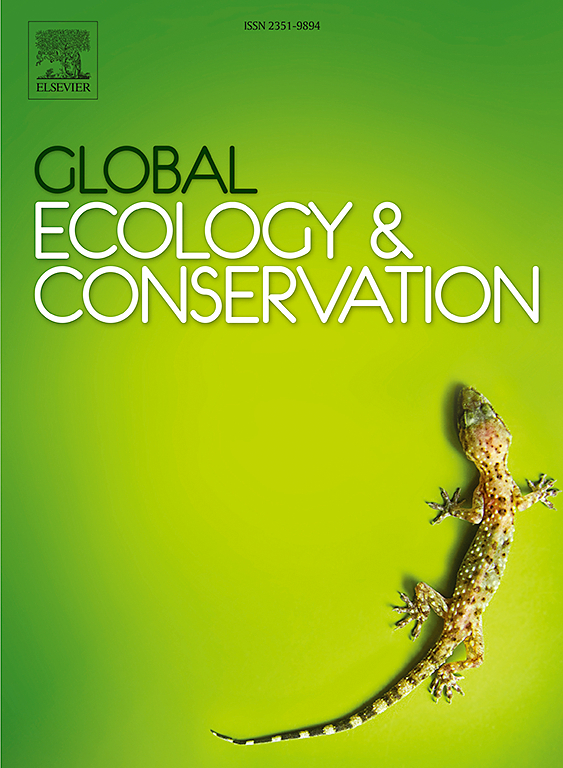Integrative population genomics and ecological niche modelling analyses illuminates the demographic history and inform conservation strategies of Calycanthus chinensis, a critically endangered shrub in subtropical China
IF 3.5
2区 环境科学与生态学
Q1 BIODIVERSITY CONSERVATION
引用次数: 0
Abstract
Climate changes have profoundly influenced the evolutionary history of plants, particularly for endangered species with narrow habitat ranges, which renders them disproportionately vulnerable to the impacts of climate change. Elucidating the spatial distribution of genetic variation and demographic patterns within threatened species populations provides essential empirical evidence for designing biologically meaningful conservation interventions. Here, we integrated population genomics with species distribution modeling analyses to investigate the genetic diversity and changes in the suitability distribution of Calycanthus chinensis, an endangered shrub in subtropical China, ultimately informing evidence-based conservation strategies for this threatened species. We assembled 75 plastomes and obtained nuclear genome-wide SNP data to address evolutionary processes of C. chinensis. The plastome-based phylogeny revealed that C. chinensis lineage diversification started in the later Pliocene (2.75 Ma) and was concentrated in the Pleistocene. Analysis of genome-wide SNPs revealed that seven populations clustered into two lineages corresponding to the two main geographic distributions. The AMOVA analyses revealed that genetic variation occurred mainly within populations. Nucleotide diversity analyses suggested that low genetic diversity may be one of a threat to C. chinensis. Demographic analyses revealed a bottleneck event from 0.4–0.7 Ma, which was associated with the Wangkun glaciation. Ecological niche modelling analyses revealed that these two genetic groups are likely to face the loss of highly suitable habits in response to future climate change. Our findings provide novel insights into the evolutionary history of C. chinensis and inform evidence-based conservation strategies.
综合种群基因组学和生态位模型分析阐明了中国亚热带极度濒危灌木Calycanthus chinensis的种群历史和保护策略
气候变化深刻地影响了植物的进化史,特别是那些栖息地范围狭窄的濒危物种,这使得它们格外容易受到气候变化的影响。阐明濒危物种种群中遗传变异的空间分布和人口统计学模式为设计具有生物学意义的保护干预措施提供了重要的经验证据。本研究将种群基因组学与物种分布模型分析相结合,研究了中国亚热带濒危灌木Calycanthus chinensis的遗传多样性及其适宜性分布的变化,为该濒危物种的保护策略提供依据。我们收集了75个质体体,获得了全核基因组SNP数据,以研究中华香椿的进化过程。基于质体体的系统发育表明,中国古树谱系分化始于上新世晚期(2.75 Ma),集中在更新世。全基因组snp分析显示,7个种群聚集成两个谱系,对应于两个主要的地理分布。AMOVA分析显示遗传变异主要发生在群体内。核苷酸多样性分析表明,遗传多样性低可能是中华月牙的威胁之一。人口统计学分析表明,在0.4 ~ 0.7 Ma发生了一个与王昆冰期有关的瓶颈事件。生态位模型分析显示,这两个遗传群体很可能因未来气候变化而失去高度适宜的生活习惯。我们的发现为中国古树的进化史提供了新的见解,并为基于证据的保护策略提供了信息。
本文章由计算机程序翻译,如有差异,请以英文原文为准。
求助全文
约1分钟内获得全文
求助全文
来源期刊

Global Ecology and Conservation
Agricultural and Biological Sciences-Ecology, Evolution, Behavior and Systematics
CiteScore
8.10
自引率
5.00%
发文量
346
审稿时长
83 days
期刊介绍:
Global Ecology and Conservation is a peer-reviewed, open-access journal covering all sub-disciplines of ecological and conservation science: from theory to practice, from molecules to ecosystems, from regional to global. The fields covered include: organismal, population, community, and ecosystem ecology; physiological, evolutionary, and behavioral ecology; and conservation science.
 求助内容:
求助内容: 应助结果提醒方式:
应助结果提醒方式:


